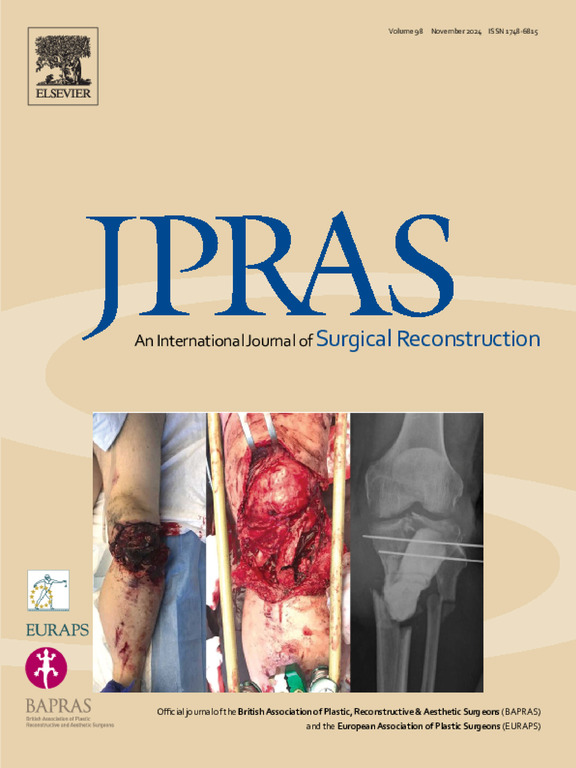The pectoralis major myocutaneous pedicled flap—Its past and current practice in a dedicated microsurgery service. Review of the literature, and debunking controversies
IF 2
3区 医学
Q2 SURGERY
Journal of Plastic Reconstructive and Aesthetic Surgery
Pub Date : 2025-02-01
DOI:10.1016/j.bjps.2024.11.047
引用次数: 0
Abstract
Background
The pectoralis major myocutaneous pedicled (PMMP) flap is still considered by many a workhorse flap in head and neck (H&N) reconstruction, despite free flap surgery advancing. The authors aimed to examine this claim and associated myths and controversies by analyzing literature trends and revealing the role of the PMMP flap in a well-established microsurgery center.
Methods
The senior author’s reconstructive H&N practice between 1995 and 2022 was reviewed to describe and critically judge primary and secondary PMMP flap decisions to provide invaluable lessons learned and debunk common controversies related to complex H&N reconstruction. A literature review from 1978 to 2022 evaluated PMMP flap articles from plastic surgery and allied H&N specialties, with a deeper analysis on publications from 2010 onward.
Results
In 27 years of practice, the senior author performed 2871 major H&N reconstructions, including 27 PMMP flaps. Both primary (13/27) and secondary (14/27) PMMP flaps decreased over time. Indications shifted from external skin compromise (fistulae/metastases) to complex medical morbidity and high-risk neck status. Neck status was increasingly evaluated based on any previous violation, surgical or irradiative, rather than simply number of remaining vessels. A literature review revealed an ongoingly abundant and primary PMMP flap use, largely by non-plastic surgeons.
Conclusion
The PMMP flap can and should be reserved for complex, high-risk or free flap-exhausted cases. Thus, current indications deserve redefinition. Multidisciplinary collaboration in specialized centers with plastic surgeons is imperative to ensure appropriate reconstructive rational and protect patient outcomes, as changing reconstructive hands and starting anew risks reconstructive regression.
胸大肌带蒂皮瓣-其过去和现在的做法,在一个专门的显微外科服务。回顾文献,驳斥争议。
背景:尽管自由皮瓣手术不断发展,但胸大肌肌蒂(PMMP)皮瓣仍被许多头颈部(H&N)重建的主要皮瓣。作者旨在通过分析文献趋势和揭示PMMP皮瓣在一个完善的显微外科中心的作用来检查这一说法和相关的神话和争议。方法:回顾资深作者1995年至2022年的H&N重建实践,描述和批判性地判断原发性和继发性PMMP皮瓣的决定,以提供宝贵的经验教训,并揭穿与复杂H&N重建相关的常见争议。1978年至2022年的文献综述评估了来自整形外科和相关H&N专业的PMMP皮瓣文章,并对2010年以后的出版物进行了更深入的分析。结果:在27年的临床实践中,作者完成了2871例H&N重建术,其中PMMP皮瓣27例。原发性(13/27)和继发性(14/27)PMMP皮瓣随时间减少。适应症从外部皮肤损害(瘘管/转移)转变为复杂的医学疾病和高危颈部状态。颈部状况的评估越来越多地基于先前的任何侵犯,手术或放疗,而不仅仅是剩余血管的数量。一篇文献综述揭示了持续丰富的和初级的PMMP皮瓣的使用,主要是非整形外科医生。结论:对于复杂、高危或游离皮瓣衰竭的病例,可以且应该保留PMMP皮瓣。因此,目前的迹象值得重新定义。专业中心与整形外科医生的多学科合作是必要的,以确保适当的重建理性和保护患者的结果,因为改变重建手和开始新的风险重建回归。
本文章由计算机程序翻译,如有差异,请以英文原文为准。
求助全文
约1分钟内获得全文
求助全文
来源期刊
CiteScore
3.10
自引率
11.10%
发文量
578
审稿时长
3.5 months
期刊介绍:
JPRAS An International Journal of Surgical Reconstruction is one of the world''s leading international journals, covering all the reconstructive and aesthetic aspects of plastic surgery.
The journal presents the latest surgical procedures with audit and outcome studies of new and established techniques in plastic surgery including: cleft lip and palate and other heads and neck surgery, hand surgery, lower limb trauma, burns, skin cancer, breast surgery and aesthetic surgery.

 求助内容:
求助内容: 应助结果提醒方式:
应助结果提醒方式:


